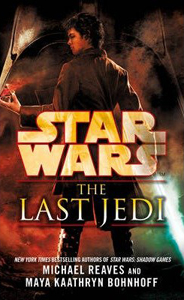The title “The Last Jedi” should be more evocative than it is. If the Jedi Order was wiped out with Order 66 in “Revenge of the Sith,” then a tale about one rogue Force-user who slipped through the cracks should be compelling. But stories like this have already been done to an almost comical degree.
Looking up the title on Wookieepedia, I found that Issue No. 49 of the Marvel comics series was titled “The Last Jedi.” There was also a 10-book young readers’ series called “The Last of the Jedi.” Obi-Wan and Yoda could both lay the claim to being the last Jedi, as could Ahsoka from “The Clone Wars.” Or Starkiller from “The Force Unleashed.” Or Kam Solusar from “Dark Empire II.” Or any of the myriad Force-users hidden in various corners of the universe that resurface in the novels where Luke (the most famous “last Jedi”) rebuilds the Jedi Order.
In Michael Reaves’ and Maya Kaathryn Bohnhoff’s February paperback, the last Jedi is Jax Pavan, a serviceable character that we’ve now followed for four books (although we met his dad, Lorn, and his trusty droid best friend I-Five, back in 2001’s “Darth Maul: Shadow Hunter”). Although I liked the three “Coruscant Nights” novels from 2008-09 and count Reaves among my top 10 “Star Wars” authors, I don’t remember a lot about those books other than the cool (albeit controversial among fans) premise of a Force-using private detective and the notion of a droid that can use the Force.
I’m sorry to say that “The Last Jedi” will fall into that same category of “forgettable.” Oddly, the authors and publisher don’t even seem to be on the same page here. The book is mostly marketed as a standalone tome that anyone can pick up, but on the inside of the cover and in Reaves’ biography, it’s referred to as the fourth “Coruscant Nights” book.
Readers should beware that it essentially IS the fourth “Nights” book. Although the action doesn’t entirely take place in the bowels of the galaxy’s capital planet, story threads from the “Nights” trilogy are picked up here. There are a few references to a Padawan of Jax’s who died in the trilogy — a plot I had forgotten about. We also get Jax’s ongoing rivalry-of-sorts with Darth Vader, which calls to mind another side character being pursued by the Sith master in “Dark Lord: The Rise of Darth Vader” (2005) and also, slightly, Vader lurking on Luke and Leia’s trail in “Splinter of the Mind’s Eye” (1978).
Jax’s romance with the Twi’lek Laranth continues here. I quite liked this thread, and indeed, the relationship between all of the main characters (including the Sullustan Den Dhur, an audience surrogate in the way he worries over various dangerous plans) is the main reason I enjoy Reaves’ work.

One of the most interesting of the authors’ threads is the notion that I-Five not only has human-like feelings (something that many science fiction authors have explored, dating back to Isaac Asimov’s robot series), but also that he can use the Force. Ultimately, I think Reaves wrote himself into a corner. In “The Last Jedi,” this thread is pushed to the background, and in the end it’s only given lip service.
Jax: “You have no midi-chlorians, I-Five.”
I-Five: “This is true.”
Jax: “But the Force lives within you. How do you account for this?”
I-Five: “It would appear that the Force works in mysterious ways. Or at least my neuroprocessor does.”
During the “Clone Wars’ ” (criminally shortened) five-year run, fans encountered some odd situations where George Lucas contradicted things established in novels, thus starting up controversies pitting Expanded Universe fans against the Lucas Knows Best crowd. Reaves was a victim of this when Even Piell, a character in “Coruscant Nights,” was killed off in the “Clone Wars,” and again when Bariss Offee, a good Jedi in Reaves’ and Steve Perry’s “MedStar” duology, was revealed to be an evil Padawan in “The Clone Wars.” (Arguably, this can be rationalized. Although we never saw Bariss knighted, it’s possible that she is indeed a Jedi Knight in Season 5, which means “MedStar” could take place before she turns bad.)
I feel like the opposite happened in “The Last Jedi” — the author is turning up his nose at Lucas. I think it’s safe to say that the notion of a droid being Force-sensitive does not fit into Lucas’ vision. And yet Reaves strongly hints that I-Five is Force-sensitive, without proposing much of an alternative explanation.
On the other hand, it’s not as if Reaves hates “The Clone Wars.” One chunk of Jax’s adventure brings him to Dathomir, giving Reaves a chance to reconcile the mostly good Witches of Dathomir from “The Courtship of Princess Leia” with the Nightsisters and Nightbrothers of “The Clone Wars.” Reaves unambiguously states that the Witches are Force-users; they simply use spells as their somewhat more primitive way of getting in touch with the Force. (I had always assumed this was the case, but during “The Clone Wars,” there were some analysts who saw Dathomiri magic as being separate from the Force.)
In the end, the skill of Reaves as a writer of character interaction (sorry to downplay Bohnhoff’s contribution here, but Reaves also does this in his solo work, so I’m simplifying) makes “The Last Jedi” a brisk read. But in the vast library of “Star Wars” literature, this “Last Jedi” doesn’t stand out from all those other last Jedis.

